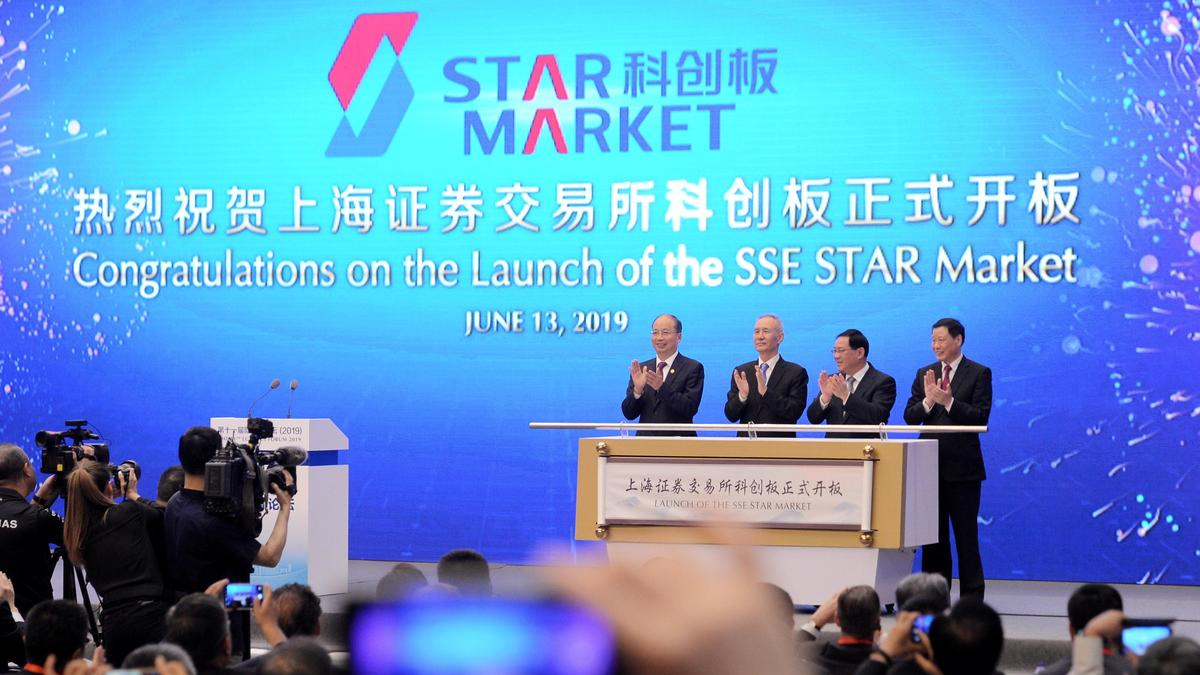

The Shanghai STAR Market will officially start trading the stocks of 25 companies on July 22. Fang Xinghai, vice chairman of the China Securities Regulatory Commission, and Que Bo, executive vice president of the Shanghai Stock Exchange, addressed top market concerns Friday on CCTV.
Average P/E ratio of 52 too high?
Some investors think the average price-earnings (P/E) ratio of the first batch of companies is too high, compared to others listed in other markets in China.
Regarding this concern, Fang pointed out that one shouldn't only look at the P/E ratio of a company but also consider its growth when investing in the STAR Market.
"The pricing process is completely a market-oriented process. The enterprises on the STAR Market usually have less profit at the beginning, but they grow faster," said Fang.
"From the perspective of historical valuation, many of the first batch companies listed have relatively mature business models, so the growth potentials are relatively large. Considering their performance in 2018, it seems that the P/E ratio is relatively high, but if you look at their performance in 2019, you would see a very high growth rate. In fact, compared with comparable companies, the valuation is not particularly high," Que added.
No worry about capital diversion
Investors are concerned that trading on the STAR Market will divert capital from other markets.
Fang said the impact of capital diversion in the new market will be limited, as evidenced by historical market data.
For example, the SME Board officially opened on June 25, 2004. After its opening, the average daily turnover of the Shanghai Main Board Market respectively decreased by 1.26 percent and increased by 1.78 percent compared with the previous week and month.
Take ChiNext -- the week and the month after the market opened, the average daily turnover of the Shanghai and Shenzhen Main Board Market and the SME Board increased significantly. The Shenzhen Main Board and the SME Board respectively increased by 16.06 percent and 17.11 percent, and the Shanghai Main Board Market rose by 15.40 percent.

China officially launches its new science and technology innovation board, June 13, 2019. /Reuters Photo
Current market figures echo historical data. According to research reports by brokerages, assuming that the average turnover rate of the first day of the STAR Market is 88.9 percent, the same as that of ChiNext, first day trading only needs to be less than 27 billion yuan (about 3.92 billion U.S. dollars). It is a small number compared with the average daily turnover of other markets.
Moreover, the capital flowing into the STAR Market will not necessarily be drawn from other markets, but can also be contributed by off-market liquidity.
"The two aspects are the keys: quality of listing companies and reasonable pricing. If we do these two aspects well, we do not need to worry about the capital. China has much off-market liquidity, as long as the STAR Market has investment value," said Fang.
What about risk control?
Unlike the Main Boards, stocks will trade without price limits during the first five days. After that, price limits are set to 20 percent, compared with only 10 percent for the Main Boards. Investors see greater risk under this trading mechanism.
Que explained why there are no price limits on trading stocks during the first five days: "We hope that the market will fully play its role, quickly form equilibrium of prices and improve pricing efficiency."
Information disclosure under the registration mechanism is the key to assessing investment risk. "We have emphasized that the information disclosed has to be real, concise and complete," Fang said.
Investors are encouraged to get familiar with the trading mechanism of the STAR Market.
Be patient
Fang said we need to be patient with the STAR Market, as it may cultivate great companies like Huawei and Google in the future.
"We require sponsors and underwriters to evaluate the companies they sponsor, to make sure they meet the requirements of the STAR Market -- that is to say, they are innovative enterprises in various fields and have certain competitiveness," Fang said.

Copyright © 2018 CGTN. Beijing ICP prepared NO.16065310-3
Copyright © 2018 CGTN. Beijing ICP prepared NO.16065310-3